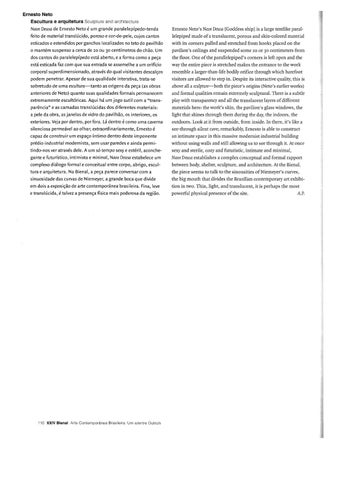Ernesto Neto Escultura e arquitetura Sculpture and architecture
Nave Deusa de Ernesto Neto é um grande paralelepípedo-tenda feito de material translúcido, poroso e cor-de-pele, cujos cantos esticados e estendidos por ganchos localizados no teto do pavilhão o mantém suspenso a cerca de 20 ou 30 centímetros do chão. Um dos cantos do paralelepípedo está aberto, e a forma como a peça está esticada faz com que sua entrada se assemelhe a um orifício corporal superdimensionado, através do qual visitantes descalços podem penetrar. Apesarde sua qualidade interativa, trata-se sobretudo de uma escultura-tanto as origens da peça (as obras anteriores de Neto) quanto suas qualidades formais permanecem extremamente escultóricas. Aqui há um jogo sutil com a "transparência" e as camadas translúcidas dos diferentes materiais: a pele da obra, as janelas de vidro do pavilhão, os interiores, os exteriores. Veja por dentro, por fora. Lá dentro é como uma caverna silenciosa permeável ao olhar; extraordinariamente, Ernesto é capaz de constru irum espaço ínti mo dentro deste imponente prédio industrial modernista, sem usar paredes e ainda permitindo-nos ver através dele. A um só tempo sexy e estéril, aconchegante e futurístico, intimista e minimal, Nave Deusa estabelece um complexo diálogo formal e conceituai entre corpo, abrigo, escultura e arquitetura. Na Bienal, a peça parece conversar com a sinuosidade das curvas de Niemeyer, a grande boca que divide em dois a exposição de arte contemporânea brasileira. Fina, leve e translúcida, é talvez a presença física mais poderosa da região.
110 XXIV Bienal Arte Contemporânea Brasileira: Um e/entre Outro/s
Ernesto Neto's Nave Deusa [Goddess ship] is a large tentlike parallelepiped made of a translucent, porous and skin-colored material with its corners pulled and stretched fram hooks placed on the pavilion's ceilings and suspended some 20 or 30 centimeters fram the fIoor. One ofthe parallelepiped's corners is left open and the way the entire piece is stretched makes the entrance to the work resemble a larger-than-life bodily orifice through which barefoot visitors are allowed to step in. Despite its interactive quality, this is above all a sculpture-both the piece's origins (Neto's earlier works) and formal qualities remain extremely sculptural. There is a subtle play with transparency and all the translucent layers of different materiaIs here: the work's skin, the pavilion's glass windows, the light that shines through them during the day, the indoors, the outdoors. Look at it from outside, fram inside. ln there, it's like a see-through silent cave; remarkably, Ernesto is able to construct an intimate space in this massive modernist industrial building without using walls and still allowing us to see thraugh it. At once sexy and sterile, cozy and futuristic, intimate and minimal,
Nave Deusa establishes a complex conceptual and formal rapport between body, shelter, sculpture, and architecture. At the Bienal, the piece seems to talk to the sinousities ofNiemeyer's curves, the big mouth that divides the Brazilian contemporary art exhibition in two. Thin, light, and translucent, it is perhaps the most powerful physical presence of the site. A.P.
